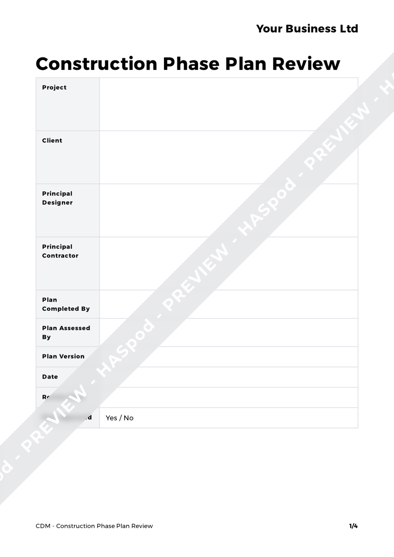Master your next building project with our expert-backed construction phase plan examples that transform complex projects into manageable milestones.
Understanding Construction Phase Plans: The Foundation of Project Success
A Construction Phase Plan (CPP) serves as the cornerstone of any successful construction project in the UK. According to recent industry data, projects with well-documented CPPs are 35% more likely to be completed on time and within budget. These essential documents, required under the Construction (Design and Management) Regulations 2015, provide a comprehensive framework for managing health and safety risks throughout the construction process. In the UK construction sector, which saw a 12% growth in 2023, effective CPPs have become increasingly crucial for project success. They serve not only as legal compliance documents but as practical roadmaps that guide projects from inception to completion while ensuring the safety of all involved parties.
Essential Components of an Effective Construction Phase Plan
- Project Information: Detailed scope, timeline, and key stakeholder details
- Risk Assessments: Comprehensive evaluation of potential hazards and control measures
- Site Rules: Clear guidelines for all workers and visitors
- Emergency Procedures: Detailed response protocols for various scenarios
- Welfare Arrangements: Facilities and provisions for workers
- Environmental Considerations: Measures to minimise environmental impact
- Training Requirements: Specific skill and certification needs
Project Description and Scope Examples
A well-crafted project description forms the backbone of your CPP. For instance, when documenting a commercial warehouse construction project, your description should include: ‘Construction of a 50,000 square foot distribution centre in Manchester, comprising groundworks, steel frame construction, and full M&E installation. Project duration: 18 months, with completion scheduled for September 2024. Key stakeholders include ABC Construction Ltd (Principal Contractor), XYZ Architects (Principal Designer), and Manchester City Council (Planning Authority).’ This level of detail ensures all parties have a clear understanding of the project’s parameters and requirements.
Management Arrangements: Real-World Examples
Effective management arrangements are crucial for project success. A recent survey by the Construction Industry Training Board found that 78% of successful projects attributed their achievement to robust management systems. Your CPP should detail specific roles and responsibilities, communication protocols, and decision-making hierarchies. For example, specify daily briefings at 8:00 AM, weekly progress meetings every Wednesday at 10:00 AM, and monthly stakeholder reviews. Include clear escalation procedures and emergency contact information for key personnel.
Risk Control Measures: Proven Examples
- Working at Height: Implementation of edge protection systems, safety nets, and personal fall arrest systems
- Plant and Equipment: Daily inspection protocols, designated operating zones, and maintenance schedules
- Manual Handling: Mechanical aids, team lifting procedures, and specific training requirements
- Hazardous Materials: COSHH assessments, storage protocols, and PPE specifications
- Public Safety: Hoarding details, security arrangements, and traffic management plans
Health and Safety Documentation Examples
Documentation forms a critical component of your CPP, with studies showing that proper record-keeping reduces incident rates by up to 45%. Essential documents include risk assessments, method statements, inspection records, and incident reports. Implement a digital documentation system that allows real-time updates and easy access for all relevant parties. Ensure all documents follow HSE guidelines and are regularly reviewed and updated.
Implementation and Monitoring Strategies
Successful implementation requires consistent monitoring and adjustment. Establish a clear timeline for regular reviews, typically weekly for high-risk activities and monthly for general progress. Include specific KPIs such as near-miss reporting rates, training completion percentages, and site inspection scores. Recent industry data shows that projects with regular monitoring systems are 40% more likely to maintain high safety standards throughout their duration.
Common Challenges and Solutions
- Challenge: Incomplete risk assessments – Solution: Implement standardised assessment templates and peer review system
- Challenge: Poor communication – Solution: Establish daily toolbox talks and digital communication platforms
- Challenge: Inadequate training – Solution: Develop comprehensive induction programmes and skills matrix
- Challenge: Document control – Solution: Implement cloud-based document management system
Creating Your Own Construction Phase Plan
To create an effective CPP, follow these essential steps: Begin with a thorough site survey and risk assessment. Consult with all stakeholders to gather comprehensive input. Use industry-standard templates as a starting point, but customise them to your specific project needs. According to recent HSE guidance, successful CPPs typically take 2-3 weeks to develop fully and should be reviewed by at least three senior team members before implementation.
Expert Tips for CPP Success
- Start development early – ideally 6-8 weeks before project commencement
- Involve all key stakeholders in the planning process
- Use clear, concise language avoiding technical jargon
- Include visual aids such as site plans and process flow charts
- Build in flexibility for unexpected changes
- Ensure regular reviews and updates throughout the project lifecycle
Conclusion: Ensuring Project Success Through Effective Planning
A well-structured Construction Phase Plan is more than just a regulatory requirement – it’s a vital tool for project success. By following these examples and guidelines, you can create a comprehensive CPP that not only ensures compliance but drives project efficiency and safety. Remember, the most successful projects are those that maintain living, breathing CPPs that evolve with the project’s needs. Regular reviews, updates, and stakeholder engagement will help ensure your CPP remains effective throughout the project lifecycle.
FAQ
What is the typical life cycle of a construction project?
This process can be broken down into five phases – planning/design, pre-construction, procurement, construction, and post-construction.
What is the construction sequence?
What is the order of construction? Construction order refers to the major sequence of work followed while constructing a building. Construction order typically starts with marking, excavation, foundation, framing, brick masonry, roofing, flooring, and finishing.
What are the 5 appropriate project life cycle or phases in order?
The project life cycle includes five phases: initiation, planning, execution, monitoring and control, and closure. Managing and tracking the work involved in each project life cycle stage can be overwhelming. Many project managers use dedicated software to assist them.
Sources
[1] https://www.southtyneside.gov.uk/media/8205/Construction-phase-plan-template/doc/3.20_Appendix_Nvi_CPP_Template.docx?m=1718797604800
[2] https://www.goconstruct.org/educational-resources/learn-about-construction/construction-phase-plan
[3] https://www.chas.co.uk/blog/what-is-a-construction-phase-plan-cpp/


Leave a Reply